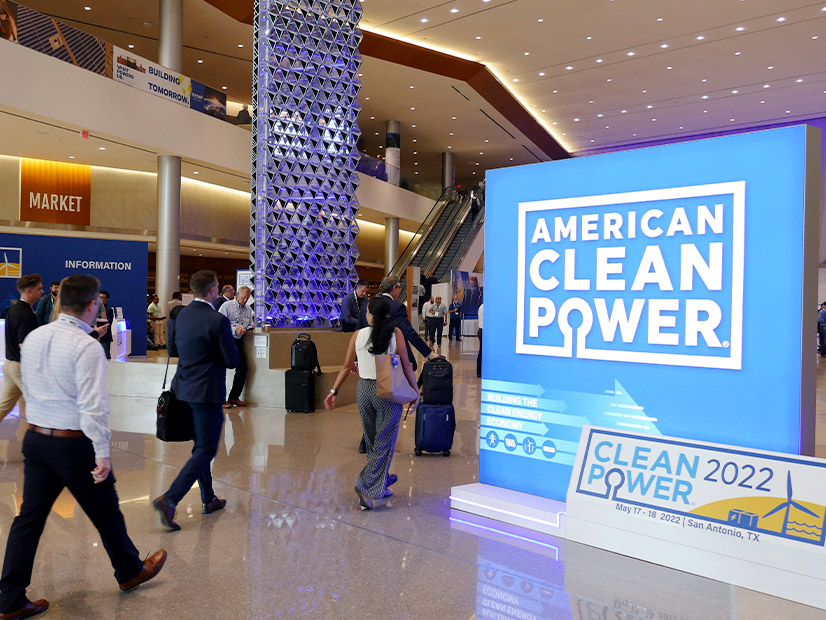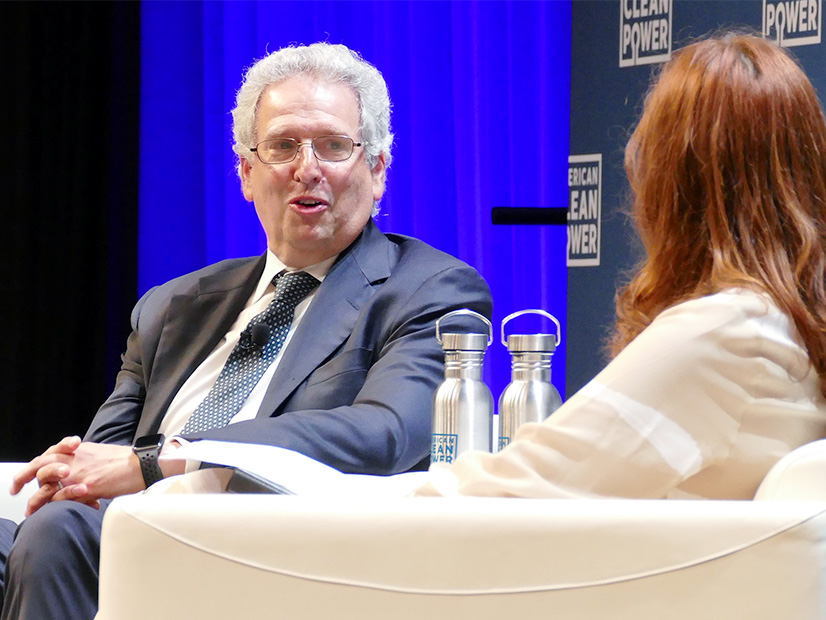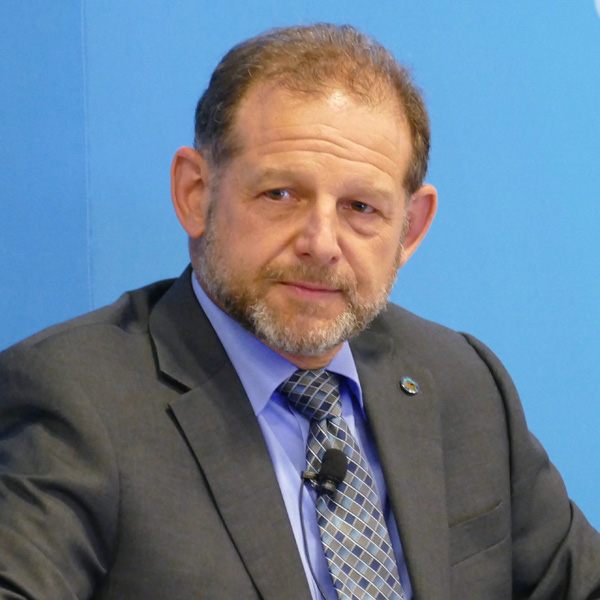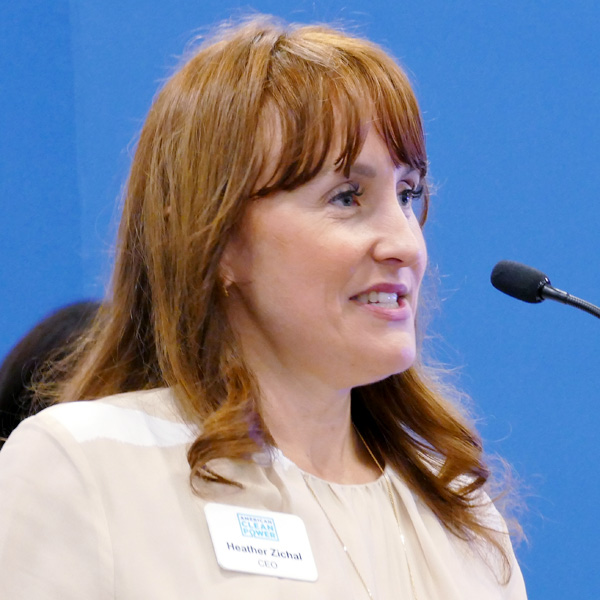SAN ANTONIO — American Clean Power (ACP) last week kicked off its annual CLEANPOWER conference by releasing its 2021 market report filled with significant milestones, but also warning of obstacles that lay ahead for the clean energy industry.
According to the report, the industry installed a record 28.5 GW of utility-scale wind, solar and battery-storage projects in 2021, accounting for 81% of all new power additions. Clean energy installations surpassed the 200-GW level during the year, providing enough electricity to power over 56 million American homes.
However, transmission bottlenecks and policy uncertainty threaten to stall future developments and the administration’s goal to reach a net-zero grid by 2035, ACP staff said, despite CLEANPOWER 2022’s video testimonials from politicians on both sides of the aisle about the renewable industry’s importance.
 American Clean Power CEO Heather Zichal briefs the media on the clean energy market report for 2021. | © RTO Insider LLC
American Clean Power CEO Heather Zichal briefs the media on the clean energy market report for 2021. | © RTO Insider LLC
“Don’t get me wrong, 2021 marked a record year for clean power,” CEO Heather Zichal said during the second day of the May 16-18 event. “But despite this laudable progress, the rate of deployment must accelerate at a much faster pace than it did in 2021.”
Zichal said the industry needs to increase its project volume by 65% over last year to reach the 2035 net-zero goal. It may be difficult to maintain the momentum of the last two years, she said, given COVID-19 challenges, inflation, supply chain constraints, trade barriers and uncertainty over the extension of tax incentives.
John Hensley, ACP’s vice president of research and analytics, said renewable energy growth in 2021 was equivalent to the previous year and that only 386 miles of new transmission were built last year, down from a yearly average of 1,800 miles over the last decade and “woefully under the volumes that we need to enable the clean energy transition.”
“This is critical. We need to be transitioning,” Hensley said. “We need to be deploying more and more renewables every year. That’s what’s needed to enable the clean energy transition. That will help to push this country towards a net-zero emissions grid by 2035.”
Optimistic Granholm Battles Headwinds
Admitting that she’s “annoyingly optimistic” about the future, U.S. Department of Energy Secretary Jennifer Granholm offered some hope to the conference’s 7,000 attendees during a taped interview with Zichal. She said her sunny outlook stems from the fact the industry’s headwinds all have one solution: clean energy.
“It’s affordable; it’s diverse; it’s reliable; and we can build it at home. The more clean energy we deploy, the more energy-secure and the more climate-secure we’re going to be,” Granholm said.
 Attendees stream into CLEANPOWER 2022. | © RTO Insider LLC
Attendees stream into CLEANPOWER 2022. | © RTO Insider LLC
And even bigger source of her optimism is working at DOE, she said, breaking the video’s “fourth wall” by frequently leaning forward from her office desk in D.C. to address those gathered before her screen.
“I feel like I have a front-row view of America’s solutions department every day. I get to watch what our 17 national labs are doing … what [the agency’s departments] are all cooking up,” she said. “The brainpower here is unmatched; the infrastructure is unparalleled; and we’re putting historic levels of resources into innovating and scaling these clean energy technologies. At the end of the day, these technologies are going to be our best tool for fixing this cascade of problems.”
Granholm, with the Ukrainian flag featured prominently behind her along with the American and DOE flags, said the war in Eastern Europe has provided the U.S. an opportunity to transition away from dependence on fossil fuels.
“Clean energy gives us the means to advance all of these priorities like climate security and energy security, especially with this war. People want to see us move away from the volatility of unabated fossil fuels. They want to see us build out this clean energy future,” she said. “The president and the entire administration have really been focused on this from day one, but the war gives us an opportunity to really foot-stomp it.”
Pointing to clean energy development in both red and blue states, Granholm said more Americans are realizing the benefits of clean energy. “We hope that their leaders, all of our leaders, catch up to them,” she said.
“I completely understand the worries, and frankly, I’ve grappled with a lot of the same concerns that you are grappling with right now,” Granholm said. “But let’s keep in mind this lesson from the past: the future is always unwritten. That has a way of surprising us when you’re making history. Sometimes you don’t see that history in the making … but I’m telling you, we’re all making history right now.”
Texas Penalizes Renewables in ERCOT Redesign
Texas industry insiders said the state’s politicians and regulators are penalizing clean energy resources as they restructure ERCOT’s market following last year’s disastrous winter storm.
 Michael Jewell, Jewell & Associates | © RTO Insider LLC
Michael Jewell, Jewell & Associates | © RTO Insider LLC
Michael Jewell, a principal with Jewell and Associates, said politicians continued to focus on renewables during last year’s legislative session after initially blaming clean resources for the loss of generation during the storm. Subsequent studies have shown that the lack of natural gas supplies accounted for the majority of generation outages during the storm’s extreme temperatures. (See FERC, NERC Release Final Texas Storm Report.)
“That was the number one problem,” Jewell said of the lawmakers’ emphasis on renewables’ intermittency. “I would not have been working so hard during the session if that had not been the focus … and it continued through the session. It shaped a lot of what actually came out of the session.”
While weatherization was a big part of the bills that passed, other pieces of legislation focused on ancillary services, their contribution to reliability and the inability of renewable resources to provide those services. As the Public Utility Commission of Texas begins to dabble in the second phase of its market redesign, it has openly discussed penalizing resources for not providing power when it is needed.
During a press conference last week in which he frequently promised no outages this summer, PUCT Chair Peter Lake highlighted the new ERCOT contingency reserve service being developed. He described it as a fast-ramping product to offset the “sun setting and dropping of solar,” with the costs of procuring the service allocated under the cost-causation principle.
“That cost, the commission decided, will be assigned to the resources causing [the drop], in this case, the intermittent resources,” he said, avoiding the use of solar or wind.
“If I get a tattoo at the end of my career, it’ll say, ‘cost causation,’ because that’s where we really lose a lot of sleep,” said the Advanced Power Alliance’s Jeff Clark, a solar advocate.
“There’s a couple of key [legislative] provisions … that focus on ancillary services, which traditionally are a real sleeper of an issue,” Jewell said. “But if you’re about to face the potential for the cost of all of those resources to be put on your industry, which is the threat that we have faced since Winter Storm Uri, it’s a huge issue that can absolutely undermine your industry.”
Bird Dog Energy’s Colin Meehan said the addition of several new ancillary services, some in the 10- to 20-GW range or higher, could amount up to $1 billion in costs to the market.
“I think what some of the political leadership would like to see is imposing those costs on renewable energy, and that’s highly concerning,” he said. “We’re trying to work with the commission to say, ‘Look, we’re open to the idea of a cost-allocation discussion, but it has to be across the entire market. It can’t be focused exclusively on one technology.’ The political side is still about renewables.”
“I think it’s important to recognize cost causation is in the eye of the beholder in this environment, so whoever is making the decision and what biases they’re bringing to the table is going to dictate what is cost causation,” Jewell said. “Even with a significant growth of wind and solar on the grid, we have not seen any incremental growth of ancillary services. It’s actually gone down. So, has wind and solar been causing the need for ancillary services? I would argue that need was already there and nothing should be allocated to renewables. But that’s not the conversation we’re going to be having because the eye of the beholder is really critical.”
FERC, DOE Address Tx Build-out
FERC Chair Richard Glick, appearing in person, addressed the commission’s April rulemaking to reform transmission-planning and cost-allocation processes. (See FERC Issues 1st Proposal out of Transmission Proceeding.)
“Everyone in this room knows that we are blessed with the world’s best renewable resources, wind, solar and other resources as well,” Glick told Zichal during a Q&A session. “And everyone knows that in many cases, those resources are located in very remote regions. We just need to build out the transmission grid to access those resources.”
 FERC Chairman Richard Glick discusses the commission’s transmission NOPR with American Clean Power’s Heather Zichal. | © RTO Insider LLC
FERC Chairman Richard Glick discusses the commission’s transmission NOPR with American Clean Power’s Heather Zichal. | © RTO Insider LLC
Glick said FERC is focused on the two toughest issues when it comes to barriers to transmission development and doing so in an anticipatory fashion.
“We know where those resources are located, so we really need to focus on what we need to better approach the transmission cost allocation as well,” he said. “I want to point out that this isn’t the end of our transmission reform agenda. We are soon hopefully going to be attacking that generator interconnection [issue], which you all know is a major, major problem both in terms of addressing the speed we need to expedite the process for transmission interconnection significantly and expedite the process. But we also need to deal with some of the cost-allocation issues there too. We need a much better approach to address participant funding.”
Still to come, said Glick, who was re-nominated as FERC chair on Friday, is dealing with interregional transmission planning, cost oversight and “a whole bunch of other issues … hopefully, relatively soon.” (See Biden to Re-nominate Glick as FERC Chair.)
At the same time, the DOE’s Grid Deployment Office has solicited comments on its Transmission Facilitation Program (TFP), a $2.5 billion fund for a once-in-a-generation grid expansion, courtesy of the Infrastructure Investment and Jobs Act. Under the TFP, DOE can offer three types of support to help build new, replacement and upgraded high-capacity transmission lines:
- capacity contracts for up to 50% of proposed transmission project’s capacity;
- loans to carry out eligible projects; and
- public-private partnerships.
“There’s so much that needs to happen to get this right, but one crucial part is making this collaborative and inclusive in a coordinated process,” Granholm said. “We want these new transmission lines to have collaboration and communication sort of in their foundation so that they meet local needs and help communities achieve their energy needs. And of course, that helps to avoid the NIMBY problems that have plagued us in the past.
“We hope that the funding carrots that were given to us in the bipartisan infrastructure law are going to be significant and being able to make sure at least early on [that] the low-hanging fruit is addressed in some of these transmission lines,” she said.
Wanted: Resolution to Chinese Solar Probe
Several speakers lamented that the Department of Commerce probe into whether Chinese companies are circumventing U.S. trade tariffs has stalled the import of solar panels. The agency opened the investigation in March to determine whether the solar panels and related equipment are actually Chinese products shipped through four other Asian countries to avoid anti-dumping and countervailing duties that would otherwise have to be paid by Chinese manufacturers. (See Solar Sector Braces for Tariff Probe Impact.)
“We need a swift resolution from the Department of Commerce on the anti-circumvention probe,” Zichal said during a press conference on ACP’s 2021 market report, noting the industry finds retroactive tariffs “very disconcerting.”
“There are tariff rates that can go up to 250%, though just the threat of that out there and the requirement that industry would have to carry that risk has led to a major standstill in the deployment of clean energy,” Zichal said.
“Many, many decisions that companies are faced with are delaying and scrapping solar projects across the country. Instead of solar projects being deployed, we are dealing with states and utilities that are making decisions to keep coal assets generating longer.
“I think the most frustrating piece of all of this is that this is a Department of Commerce decision that is 100% discretionary. So, we’ve got a Biden administration that says a lot of the right things about deploying clean energy but then when you look at the policies and the substance, we’re actually going in the wrong direction,” she added.
Zichal later conducted a live video interview with Sen. Martin Heinrich (D-N.M.), who was among a group of senators that participated in a conference call May 17 with administration officials.
“The White House is now fully now aware of just how devastating the … current uncertainty in the industry is for jobs across the country,” Heinrich said. “They’re on [defensive readiness condition] five now, understanding that this has to be resolved really quickly to reinsert the level of certainty and predictability back into the market. I think they’re being very careful to make sure that whatever they do complies to the absolute letter of the law, but the speed and the necessity of resolving this very quickly seems to be something that that they are fully embracing at this point.”
“I completely understand that the uncertainty around trade regulations is ‘interfering,’ a gentle word, with the industry’s ability to scale up,” Granholm said during her taped interview. “Obviously, I’m extremely troubled by what that means for our climate goals. This administration is looking at every tool available to support the domestic solar energy industry. Ultimately, we do have to ramp up and build this whole supply chain at home as quickly as possible.”
Gulf of Mexico’s Offshore Wind Potential
A panel discussing the growing offshore wind market touted the Gulf of Mexico’s potential resources in a region where the oil and gas industry has long held sway. Ironically, the fossil fuel industry’s offshore expertise will play a role in the administration’s target of 30 GW of installed offshore wind capacity by 2030.
 Mike Celata, Bureau of Ocean Energy Management | © RTO Insider LLC
Mike Celata, Bureau of Ocean Energy Management | © RTO Insider LLC
Mike Celata, the Gulf’s regional director for the U.S. Department of the Interior’s Bureau of Ocean Energy Management, said the agency may be able to auction off leases as soon as early 2023, but not before conducting an auction for the Pacific Ocean off California. Celata’s office is responsible for all leasing, regulatory oversight and resource management functions for offshore energy in the U.S. Gulf.
“We’re at the point where we’re ready to define wind energy areas and an area ID’d where we can actually have leases defined and those leases become available … so it’s an exciting time,” he said. “Maybe we’re a little behind, but we have a lot of lessons to learn from the other for the other areas and a lot of lessons to learn from the oil and gas industry. I think the Gulf can clearly be a leader in offshore wind in the future.”
Celata credited Louisiana Gov. John Bel Edwards’ request for a task force that is coordinating renewable energy planning activities on the Gulf’s outer continental shelf and serving as a forum to discuss stakeholder issues and exchange data. The state has also approved a sweeping climate plan that includes a goal of 5 GW of offshore wind development by 2035.
ACP’s Joshua Kaplowitz, the panel’s moderator, recalled his time at Interior’s solicitor’s office, when he spent maybe 1% of his time on Gulf of Mexico issues. He asked Celata what accounts for the acceleration of offshore wind activity.
“Sometimes it takes a long time for the federal government to get things moved, but we have operational experience in the Gulf of Mexico,” Celata said. “We turned our operations on our oil and gas into working on wind. In the future when we get to the cost stage and development, hopefully we can apply that experience as well to turning projects around the office.”
Robert Miner with BP — which attempted to rebrand itself as Beyond Petroleum before the Deepwater Horizon disaster — said the Gulf will remain a “vital oil and gas center for many years to come.” He also said employees’ expertise in offshore development will be easily transferable to wind production.
“We’re already seeing within our company as BP employees get excited about these new energy opportunities,” Miner said. “We are seeing this kind of the excitement that people say, ‘Look, I know how to work on the water. I know how to work with transmission. I know how to work with procurement. I know how to work with all these things that are important to those businesses and numbers.’ There’s just no question that while there are some similarities, there are also some specialized jobs that are going to need specific training.”
“It goes back to the Gulf of Mexico being a place that businesses, energy businesses and people are comfortable with,” Celata said. “We’ve had recreational fishermen say, ‘Get the steel in the ground now,’ because they want more artificial reefs where they can fish. I mean, there are great opportunities.”

